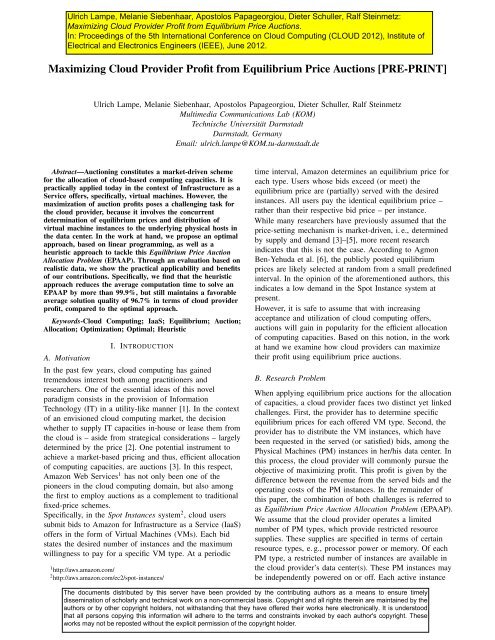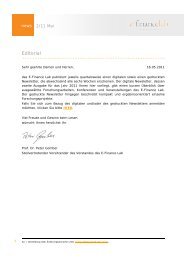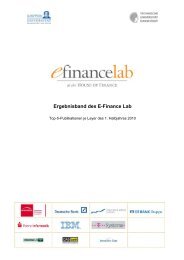Prof. Dr. Wolfgang König, Prof. Dr.-Ing. Ralf ... - E-Finance Lab
Prof. Dr. Wolfgang König, Prof. Dr.-Ing. Ralf ... - E-Finance Lab
Prof. Dr. Wolfgang König, Prof. Dr.-Ing. Ralf ... - E-Finance Lab
You also want an ePaper? Increase the reach of your titles
YUMPU automatically turns print PDFs into web optimized ePapers that Google loves.
Maximizing Cloud Provider <strong>Prof</strong>it from Equilibrium Price Auctions [PRE-PRINT]<br />
Ulrich Lampe, Melanie Siebenhaar, Apostolos Papageorgiou, Dieter Schuller, <strong>Ralf</strong> Steinmetz<br />
Multimedia Communications <strong>Lab</strong> (KOM)<br />
Technische Universität Darmstadt<br />
Darmstadt, Germany<br />
Email: ulrich.lampe@KOM.tu-darmstadt.de<br />
Abstract—Auctioning constitutes a market-driven scheme<br />
for the allocation of cloud-based computing capacities. It is<br />
practically applied today in the context of Infrastructure as a<br />
Service offers, specifically, virtual machines. However, the<br />
maximization of auction profits poses a challenging task for<br />
the cloud provider, because it involves the concurrent<br />
determination of equilibrium prices and distribution of<br />
virtual machine instances to the underlying physical hosts in<br />
the data center. In the work at hand, we propose an optimal<br />
approach, based on linear programming, as well as a<br />
heuristic approach to tackle this Equilibrium Price Auction<br />
Allocation Problem (EPAAP). Through an evaluation based on<br />
realistic data, we show the practical applicability and benefits<br />
of our contributions. Specifically, we find that the heuristic<br />
approach reduces the average computation time to solve an<br />
EPAAP by more than 99.9%, but still maintains a favorable<br />
average solution quality of 96.7% in terms of cloud provider<br />
profit, compared to the optimal approach.<br />
Keywords-Cloud Computing; IaaS; Equilibrium; Auction;<br />
Allocation; Optimization; Optimal; Heuristic<br />
A. Motivation<br />
I. INTRODUCTION<br />
In the past few years, cloud computing has gained<br />
tremendous interest both among practitioners and<br />
researchers. One of the essential ideas of this novel<br />
paradigm consists in the provision of Information<br />
Technology (IT) in a utility-like manner [1]. In the context<br />
of an envisioned cloud computing market, the decision<br />
whether to supply IT capacities in-house or lease them from<br />
the cloud is – aside from strategical considerations – largely<br />
determined by the price [2]. One potential instrument to<br />
achieve a market-based pricing and thus, efficient allocation<br />
of computing capacities, are auctions [3]. In this respect,<br />
Amazon Web Services 1 has not only been one of the<br />
pioneers in the cloud computing domain, but also among<br />
the first to employ auctions as a complement to traditional<br />
fixed-price schemes.<br />
Specifically, in the Spot Instances system 2 , cloud users<br />
submit bids to Amazon for Infrastructure as a Service (IaaS)<br />
offers in the form of Virtual Machines (VMs). Each bid<br />
states the desired number of instances and the maximum<br />
willingness to pay for a specific VM type. At a periodic<br />
1 http://aws.amazon.com/<br />
2 http://aws.amazon.com/ec2/spot-instances/<br />
time interval, Amazon determines an equilibrium price for<br />
each type. Users whose bids exceed (or meet) the<br />
equilibrium price are (partially) served with the desired<br />
instances. All users pay the identical equilibrium price –<br />
rather than their respective bid price – per instance.<br />
While many researchers have previously assumed that the<br />
price-setting mechanism is market-driven, i. e., determined<br />
by supply and demand [3]–[5], more recent research<br />
indicates that this is not the case. According to Agmon<br />
Ben-Yehuda et al. [6], the publicly posted equilibrium<br />
prices are likely selected at random from a small predefined<br />
interval. In the opinion of the aforementioned authors, this<br />
indicates a low demand in the Spot Instance system at<br />
present.<br />
However, it is safe to assume that with increasing<br />
acceptance and utilization of cloud computing offers,<br />
auctions will gain in popularity for the efficient allocation<br />
of computing capacities. Based on this notion, in the work<br />
at hand we examine how cloud providers can maximize<br />
their profit using equilibrium price auctions.<br />
B. Research Problem<br />
When applying equilibrium price auctions for the allocation<br />
of capacities, a cloud provider faces two distinct yet linked<br />
challenges. First, the provider has to determine specific<br />
equilibrium prices for each offered VM type. Second, the<br />
provider has to distribute the VM instances, which have<br />
been requested in the served (or satisfied) bids, among the<br />
Physical Machines (PM) instances in her/his data center. In<br />
this process, the cloud provider will commonly pursue the<br />
objective of maximizing profit. This profit is given by the<br />
difference between the revenue from the served bids and the<br />
operating costs of the PM instances. In the remainder of<br />
this paper, the combination of both challenges is referred to<br />
as Equilibrium Price Auction Allocation Problem (EPAAP).<br />
We assume that the cloud provider operates a limited<br />
number of PM types, which provide restricted resource<br />
supplies. These supplies are specified in terms of certain<br />
resource types, e. g., processor power or memory. Of each<br />
PM type, a restricted number of instances are available in<br />
the cloud provider’s data center(s). These PM instances may<br />
be independently powered on or off. Each active instance








